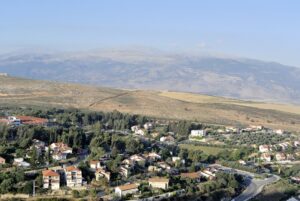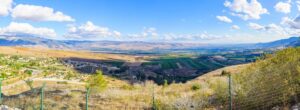Metula is a city of Israel that is located close to the northern border with Lebanon. Moreover, it is the northernmost town in Israel, and it is close to the biblical cities of Abel Bet Ma’akha, Dan and Ijon.

The history of Metula
The history of Metula dates back to the Roman and Byzantine periods since archaeologists discovered ancient wine presses and mosaic pavements. In 1967, a tomb containing four graves dating back to the third and sixth centuries was found. The name Metula comes from the Arabic Mutallah, which means the lookout. In 1816, the traveller Buckingham visited a big village called Metully that Druses inhabited. In 1875, Victor Guérin wrote a description about Methelleh or Metelleh as a village with a well and occupied by Druzes from the Hauran, who were cultivating a garden in the eastern area. In 1881, the Palestine Exploration Fund described El Mutallah as a small village with stone houses of almost 100 Druzes, which was located on the slope of a hill, close to a big stream and surrounded by cultivable land. During the Druze Rebellion in 1895, Jabur Bey Riskalas, a Greek Diplomat in the Middle East coming from Sidon, sold almost 13 square kilometres of land to Baron de Rothschild’s chief officer Joshua Ossovetski.

In 1904, after the Druze rebellion had been suppressed, after eight years of disputes and violent clashes, an agreement was reached between the Druze villagers and the Jewish Colonization Association for an additional payment of 60 thousand francs. In June 1896, 60 farming families from other settlements and 20 families of non-farming professions founded the Jewish moshava settlement. The majority of the founders were immigrants from Russia; afterwards, pioneers from Petah Tikva moved to Metula, followed by some religious scholars from Safed. In the last period of World War I, Metula was part of the French military occupation area. In the 1920 boundary agreement between Britain and France, Metula was supposed to be in Palestine, but in 1924, the British controlled all the country. The British built the bridge over Nahal Ayyun between 1943 and 1944. And on June 1946, the British soldiers captured many Yishuv leaders and Palmach members, who were Jewish residents of the Land of Israel prior to the establishment of the State of Israel. The bridge was destroyed during the War of Independence and restored in the 1980s.
When the State of Israel was established, Metula became a wealthy city well-known as a tourist attraction. The Good Fence of Metula was a border from Metula to Lebanon that closed in 2000, after the evacuation of Israel from Lebanon. The population of southern Lebanon crossed the border to dins jobs in northern Israel, to attend Israeli schools, access health services and transport goods. During the South Lebanon conflict, on 10 March 1985, while a convoy of IDF soldiers on Safari model trucks was driving from Metula towards the Lebanese town of Marjayoun, crossing the bridge of Nahal Ayyun, a red Chevrolet pickup truck driving towards them exploded in a giant fireball killing twelve soldiers and wounding fourteen during the explosion. During the 2006 Lebanon War, Metula was a ghost town because its inhabitants fled to escape the Hezbollah rockets since 120 missiles had hit the city.
All You Need To Know About Metula
Metula is located in the northernmost locality of Israel, close to the Lebanese border at 520 meters above sea level. The winter is cold and wet, with an average rainfall level of 900 mm per year. The summer is warm and dry. The river Nahal Ayoun owns its sources in Lebanon at almost seven kilometres north of Metula. On clear days, it is possible to see Lebanon and Syria. The economy of Metula is based on tourism and agriculture. And as was explained in the previous paragraph, Metula was founded in 1896 by Baron Edmond de Rothschild after he purchased the land from Druze owners. Metula started as a semi-cooperative agriculture community, and Baron Edmond de Rothschild helped Russian immigrants settle in the town. Most of the immigrants were escaping the pogroms against Jewish people that occurred in Russia during that period. Other pioneers, also named Chalutzim in Hebrew, originally from Petach Tikva, settled in Metula as well. Afterwards, some Talmudic scholars coming from Tzfat moved to Metula. After a century, Holocaust survivors emigrated to Metula, residing there.

After many years of hard work, the residents transformed Metula into a flourishing garden, considering that the town was a barren wasteland at the beginning. Hence, Metula became an ideal tourist destination. Mount Hermon is located east of Metula, with its characteristic white snowy peak in the winter and spring. In the south of Metula, there is the fertile and lush Hula Valley.
Metula is featured by gorgeous gardens and orchards that change colours every season. This fantastic town produces many fruits such as apricots, apples, cherries, nectarines, peaches, pears and plums, which are also exported to foreign countries in the world.
In the north of Metula, there are the snowy Lebanese Mountains, and in the east, there are four waterfalls: the Ayun, the Eshed, the Tachana and the Tannur. The Ayun stream runs from the Ayun valley in Lebanon, and it carved a small canyon that is now full of vegetation located in the east of Metula, ending up to the Jordan River and the Sea of Galilee. This area of the Ayun Canyon is stunning, and it is pleasant to have long walks in its nature reserve, which is full of beautiful landscapes, flowers, and waterfalls. Indeed, this is a real enchanted and magic world!
Towards Har Hazfiya, which means “The Look-out Mountain” in Hebrew, in the western area of the town, an observation point that is well–known as the Dado Lookout is located. From the Dado Lookout, the whole Hula valley, Mt. Hermon, the Mountains of the Upper Galilee region, the Golan Heights, and Lebanon can be admired in a fascinating and unique view.
Different landmarks are in the downtown of Metula, including the Community Centre, the Farmers Museum and the House of Art. There is a permanent exhibition in the museum about the history and the very first days of the settlement. Metula also owns an extensive public library close to the downtown and the Canada Centre, which is one of the main tourist attractions of Metula. The Canada Centre is the core of the community with a beautiful view of Galilee. The Centre is the largest sports centre in this area offering sports and recreation activities. Nowadays, at the Canada Centre, the Russian and Ukrainian immigrants have become top Olympic figure skaters and World-Class speed skaters. One of the most popular sports in Israel is ice-skating. Visitors are welcome to use skates provided by the Centre, and also take a lesson from one of the very well experienced professional trainers. Additionally, international ice shows often take place. Another popular activity is swimming, and in the Centre, there is a heated indoor pool with two jacuzzis and a pool suitable for children and an outdoor pool that is open in the summertime, with a water slide and a pool for children. In the Centre, there are many restaurants and a health centre with spas, wet and dry sauna, and a jacuzzi. The Centre additionally includes a rifle range, a gun shop, a sports clothing shop, a gift shop, and a 10-lane bowling alley.

In Metula, there is a wide range of hotels, both big and small, besides guest houses and restaurants. So many attractions are present in such a small town that you will be surprised and amazed. Moreover, the people of Metula are hospitable, as well as their ancestors who established and created the town. Hence, you can plan your holiday in Metula and in the surrounding area, including Galilee and Mount Hermon. The stunning nature and enchanting places will amuse you.

